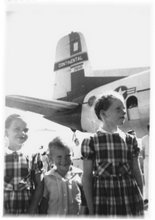"I came across your blog today and enjoyed it.
I wanted to point you to the top article on my blog that urges the FAA to adopt more aggressive goals for general aviation. You’ll find it at www.maxtrescott.com if you’re interested in linking to it."
Max Trescott is an aviation author in the San Francisco Bay Area who has written aviation safety books and has appeared on radio. He also publishes an "online newsletter [snip] to promote safe flying with emphasis on regional differences in flying risk factors."
I had my only, true, near-miss at SJC. I was cleared for final for 30R and suddenly I glanced to my right and saw a Cessna 172 turning right base for the same runway. The pilot never glanced at me and was intently staring at the runway to his right. I used some "non-pilot" verbiage on the radio and only averted a collision when I chopped power and dove under him. The tower finally switched to RHV tower frequency and advised he was not at RHV, but at SJC and to climb immediately over the taxiway.
The pilot leveled out and continued straight down the centerline of 30R. I screamed at the tower something to effect of wanting his reproductive organs to be removed and to get his N-number.
The funny part? I had my brother-in-law's son as a first-time flier in the right seat and he was never aware of the incident and only commented on my "beautiful landing on the numbers". Go figure....
Added: Max Trescott's article is really a good read and goes into some of the causes of accidents in the G.A. community. I was especially interested in the fact that 21% of all accidents happen at night even though they only account for 5% of the total flight time.
Since I worked graveyard shift at SCVMC in the E.R., most of my flying on my nights off...was at night. I really believe that flying at night is akin to flying IFR and needs a certain skill set. During my flight training, Jerry had me fly under the hood and shoot ILS approaches to minimums. This was for my Private ticket. Thanks Jerry!
I flew almost exclusively at night and was VERY current. My rules were:
1) CAVU at night or "no-go".
2) Dual NAV's and dual COMM's (working) or "no-go".
3) Mandatory oxygen over 6,000 feet.
Seem extreme? I never thought so. The fact that I never had a single moment where I felt any question as to the safety of the flight and never even had an incident bears out my rules.
Wednesday, January 2, 2008
Updated: A Note From Max Trescott
Posted by
Hugo
at
1/02/2008 08:43:00 AM
![]()
![]()
Subscribe to:
Post Comments (Atom)


No comments:
Post a Comment